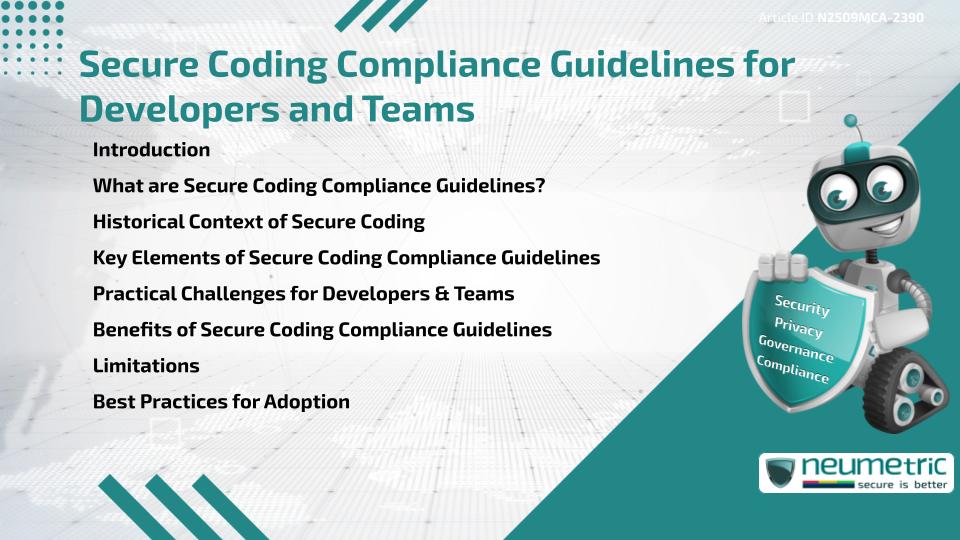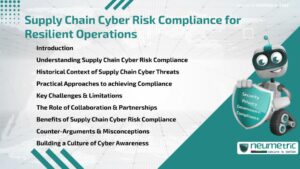Table of Contents
ToggleIntroduction
Secure Coding Compliance Guidelines are essential for reducing Vulnerabilities in Applications & Protecting Enterprise Systems from Cyber Threats. As Applications are a frequent target of Attacks, weak Coding Practices can lead to Breaches, Downtime & Regulatory Penalties. By following Compliance Guidelines, Developers & Teams embed Security into the Software Development Lifecycle, ensuring safer & more resilient Applications.
What are Secure Coding Compliance Guidelines?
Secure Coding Compliance Guidelines are Structured Practices & Policies that Developers must follow to write Secure Software. These Guidelines align with Frameworks such as NIST, ISO 27001 & the OWASP Foundation. They cover topics like Input Validation, Error Handling, Access Control & Encryption to ensure that Applications meet Regulatory & Industry Standards.
Historical Context of Secure Coding
In the early years of Software, Security was often neglected, with Developers focusing primarily on Functionality. However, widespread incidents of SQL Injection, Buffer Overflows & Cross-site Scripting highlighted the dangers of Insecure Code. In response, organisations & Regulators promoted Secure Coding Compliance Guidelines as part of broader Security Governance, making them a fundamental requirement for Developers & Teams.
Key Elements of Secure Coding Compliance Guidelines
An effective set of Guidelines should include:
- Input Validation: Prevent malicious Data from exploiting Applications.
- Authentication & Access Control: Enforce Least Privilege & Multi-factor Authentication.
- Error Handling: Avoid exposing Sensitive Information through System Errors.
- Data Protection: Encrypt Data In Transit & At Rest.
- Code Reviews: Conduct Peer reviews to identify potential Vulnerabilities.
- Secure Libraries: Use verified & updated Third Party Components.
- Audit Logging: Track critical Operations for Accountability & Compliance.
Practical Challenges for Developers & Teams
Following Secure Coding Compliance Guidelines can be challenging due to time pressures, lack of Training or resource limitations. Developers may struggle to balance speed of delivery with Security Practices. Legacy Applications & Outdated Frameworks also pose challenges, requiring significant effort to retrofit Compliance.
Benefits of Secure Coding Compliance Guidelines
Despite these obstacles, adopting Secure Coding Practices delivers multiple benefits:
- Reduced exposure to Vulnerabilities & Cyberattacks
- Stronger Compliance with Regulations such as GDPR, HIPAA & PCI DSS
- Improved trust with Clients, Partners & Regulators
- Greater efficiency by preventing costly Rework or Post-release Patches
- Integration of Security into DevSecOps Pipelines for Continuous resilience
Limitations
Some critics argue that Compliance Guidelines may slow down Development & Reduce Agility. Others note that Guidelines alone cannot prevent all Vulnerabilities, especially if Developers lack Practical Training or If Secure Coding is treated as a Box-ticking exercise rather than a Cultural shift.
Best Practices for Adoption
To embed Secure Coding Compliance Guidelines effectively, organisations should:
- Provide regular Training & Certifications for Developers
- Automate Code Scanning & Vulnerability Detection in CI/CD Pipelines
- Conduct regular Peer Reviews & Security Audits
- Tailor Guidelines to the organisation’s Regulatory & Operational needs
- Align practices with Global Best Practices from OECD, World Bank & ENISA
Takeaways
Secure Coding Compliance Guidelines are a foundation for resilient & trustworthy Applications. By integrating them into Development workflows & aligning with Global Standards, organisations can reduce Risks, meet Compliance Requirements & Build Secure Software environments.
FAQ
What are Secure Coding Compliance Guidelines?
They are Structured practices that ensure Software is Developed securely & meets Industry Standards.
Why are they Important?
They reduce Vulnerabilities, improve Compliance & Enhance resilience against Cyber Threats.
What challenges do Developers face?
Challenges include balancing speed with Security, Training gaps & managing legacy Systems.
What are Key Elements of these Guidelines?
Input Validation, Access Control, Error Handling, Encryption, Reviews & Audit Logging.
Do Guidelines guarantee fully Secure Software?
No, but they greatly reduce Risks when combined with ongoing Training & Monitoring.
References
- NIST CyberSecurity Framework
- ISO 27001 – Information Security
- OWASP Foundation
- OECD Privacy Guidelines
- ENISA – European Union Agency for CyberSecurity
Need help for Security, Privacy, Governance & VAPT?
Neumetric provides organisations the necessary help to achieve their CyberSecurity, Compliance, Governance, Privacy, Certifications & Pentesting needs.
Organisations & Businesses, specifically those which provide SaaS & AI Solutions in the Fintech, BFSI & other regulated sectors, usually need a CyberSecurity Partner for meeting & maintaining the ongoing Security & Privacy needs & requirements of their Enterprise Clients & Privacy conscious Customers.
SOC 2, ISO 27001, ISO 42001, NIST, HIPAA, HECVAT, EU GDPR are some of the Frameworks that are served by Fusion – a SaaS, multimodular, multitenant, centralised, automated, CyberSecurity & Compliance Management system.
Neumetric also provides Expert Services for technical Security which covers VAPT for Web Applications, APIs, iOS & Android Mobile Apps, Security Testing for AWS & other Cloud Environments & Cloud Infrastructure & other similar scopes.
Reach out to us by Email or filling out the Contact Form…





